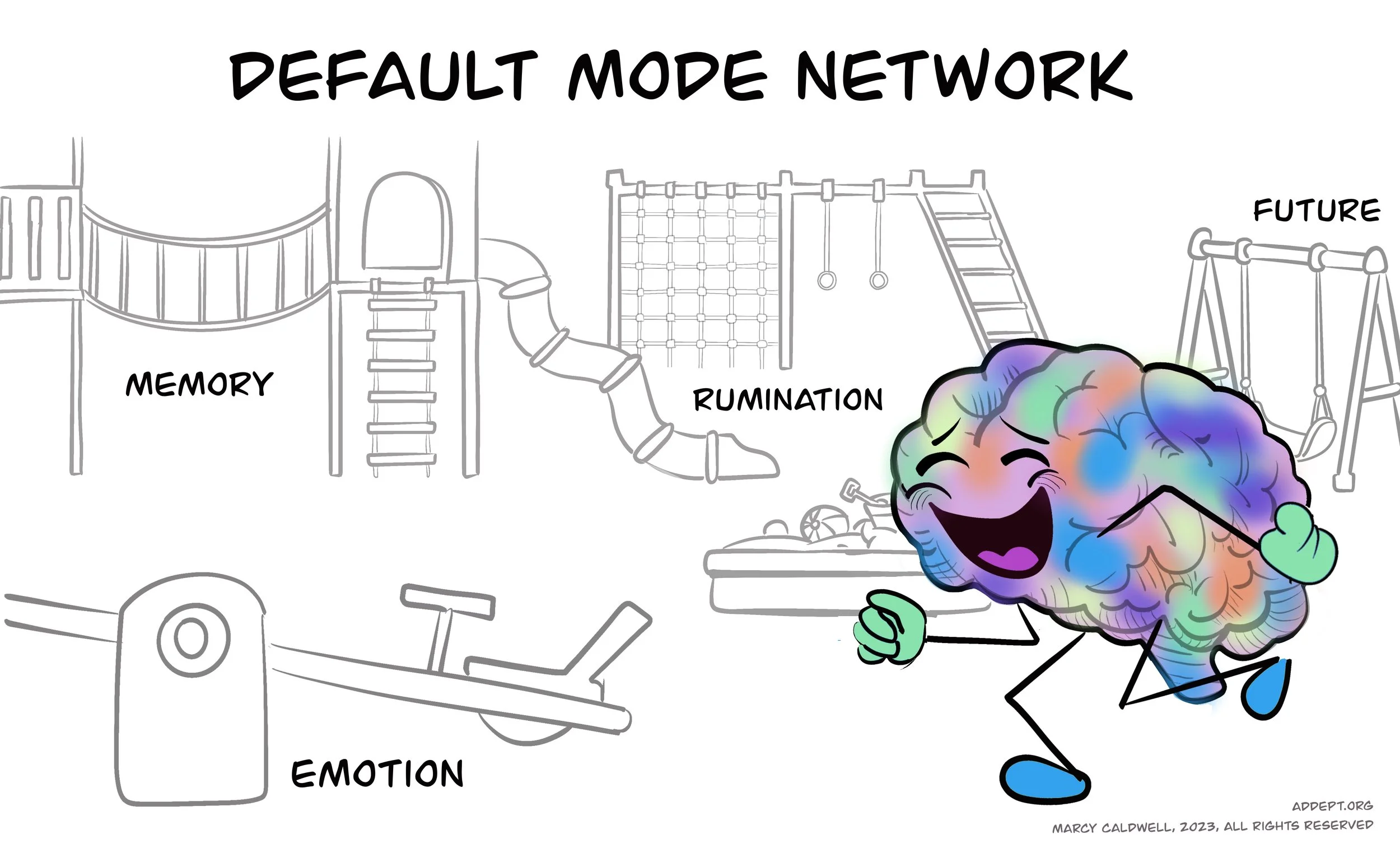The ADHD Brain Revealed:
The Surprising Truth of the Default Mode Network
You’re staring at your computer screen, one sentence of the report written– it took 45 minutes of hard effort to get here… And suddenly, you’re no longer thinking about this quarter’s earnings, instead, you’re right back at the awkward bar-b-que last weekend, replaying it all in your head:
What did my sister-in-law mean by that comment, exactly? Why is she always so judgemental? Oh, how I wish I could say what I really want to say. But maybe she didn’t mean anything by it. She’s actually pretty kind- everyone else thinks she’s great. I’m always reading the worst into things. Ugh… no wonder she doesn’t like me.
It’s the endless chatter, the ruminations, and obsessive thinking that act as a siren call for your brain, drawing you away from focus and direction and towards circling thoughts soaked in emotion.
What’s going on? It’s your overactive default mode network.
What’s the Default Mode Network?
The default mode network is the network of brain regions and activities involved when your brain isn’t focused on a goal-directed activity. So when you’re sitting at your desk, staring out the window, in the shower, driving on an endless highway, or your mind has wandered during a lecture- that’s when your brain enters the default mode network. It’s the brain regions at play when you’re daydreaming, recalling memories, thinking about the future, etc.
I like to think of the default mode network as our brain at recess. It’s wandering wherever it feels like; one minute, it’s on the slide, the next, it’s headed over to the swings, and a few minutes after that, it’s doing the monkey bars over and over again.
Our brains do the same thing- thinking about one thing and then the next. But because the default mode network incorporates the memory and feeling centers of the brain, a lot of the “playing” that your brain does here can be very emotional and often focused on the past.
But recess isn’t the only place your brain hangs out during the day. It also gets to work with a network called the task-positive network.
Think you might have ADHD?
Take a free online assessment to find out.
(Takes 3 minutes)
TAKE THE QUIZWhat’s the Task Positive Network?
The task-positive network (or TPN) is the part of our brain that’s responsible for goal-directed activity. This is the network of brain regions that lights up when we focus on a task that requires conscious attention. The task-positive network involves more of our frontal cortex (the part of our brain responsible for rational, sequential thought) and less of the emotional and personal memory stores.
The TPN is where our brain goes when it’s called in from recess. It’s the brain hard at work: studying, learning, creating, and problem-solving.
ADHD and the Default Mode Network
All brains have TPNs and DMNs. But ADHD brains have a particularly hard time leaving recess— not just because recess is compelling but because an ADHD brain’s Default mode network doesn’t turn off when the task-positive network turns on, like a neurotypical brain does.
It’s as if the classroom and the playground have no wall between them- just desks set up right next to some of the most colorful, intriguing, and interesting playground equipment you can imagine. So even if an ADHD brain comes in and sits down at their desk, the siren call of the slide and monkey bars starts calling pretty quickly, and pretty soon, it just gets up and wanders on over to start playing.
What does that mean?
Well, it means it’s going to get a lot less work done, but it also has some other difficult impacts as well:
ADHD Distraction
Having the monkey bars set up right next to your desk can make it pretty hard to stay focused and on track. Because that playground, the area of your brain where it gets to follow every impulse and interest, never goes away. It’s like your brain is playing 2 channels at the same time- C-span and Bravo. Sure, one may be more important for your life, but those real housewives- they’re pretty compelling. So you’re constantly flipping back and forth- hearing the siren call of the DMN again the minute you finally get settled in and back to work. Over and over again.
ADHD Obsessive Thinking
Because the brain gets to wander anywhere it wants on the playground, it’s able to stay stuck in one spot- swinging on the swings for hours on end or going up and down the slide over and over again. And because this default mode network playground is so compelling, it very often does do just that, gets stuck on one line of thought over and over again.
This is where obsessive and ruminative thinking comes from in ADHD brains. It’s the endless loop of one activity over and over again, and because there is no purpose or goal, the brain gets to stay there. So that little comment your sister-in-law made at the BBQ? It gets played on repeat.
Anxiety and Depression
As anyone who has survived elementary school can attest to, as much as we want our playgrounds to be only places of fun, laughter, and friendships— sometimes it’s anything but.
In fact, playgrounds can be torture.
And the default mode playground is no different. Because it’s a place of purposeless emotion, memory, and forecasting, it’s ripe for depression and anxiety- being a spot where our brain will circle over and over on the most emotionally compelling (i.e., dark, negative, and fear-inducing) thoughts.
So, the brain you were born with built the classroom outside on the playground. How are you supposed to keep it off the slide and focus on its work?!?
Well, there are a variety of things you can do to help keep that brain off the slide and back at its desk. Check out the next post on:
7 Proven Techniques to Tame Your Default Mode Network and Boost Your Focus
What have you noticed about your DMN? Is it a happy playground or one full of darkness? Share in the comments below!
Resources:
Garrison KA, Zeffiro TA, Scheinost D, Constable RT, Brewer JA. Meditation leads to reduced default mode network activity beyond an active task. Cogn Affect Behav Neurosci. 2015 Sep;15(3):712-20. doi: 10.3758/s13415-015-0358-3. PMID: 25904238; PMCID: PMC4529365.
Liddle, E. B., Hollis, C., Batty, M. J., Groom, M. J., Totman, J. J., Liotti, M., ... & Liddle, P. F. (2011). Task‐related default mode network modulation and inhibitory control in ADHD: Effects of motivation and methylphenidate. Journal of Child Psychology and Psychiatry, 52(7), 761-771.
Uddin, L. Q., Kelly, A. C., Biswal, B. B., Margulies, D. S., Shehzad, Z., Shaw, D., ... & Milham, M. P. (2008). Network homogeneity reveals decreased integrity of default-mode network in ADHD. Journal of neuroscience methods, 169(1), 249-254.
Rubia, Katya, Analucia Alegria, and Helen Brinson. "Imaging the ADHD brain: disorder-specificity, medication effects and clinical translation." Expert review of neurotherapeutics 14.5 (2014): 519-538.
Westbrook, Andrew, and Todd S. Braver. "Dopamine does double duty in motivating cognitive effort." Neuron 89.4 (2016): 695-710.
Ready to shift from
meltdown to mastery?
This online course has been designed specifically to help teach the strategies ADHD brains need to help them move from overwhelm and meltdowns to confident emotional mastery.
Want to know more about
thriving with ADHD?
Check out these other articles:
























ADHD Packing Tips: Master Stress-Free Travel with these ADHD Hacks